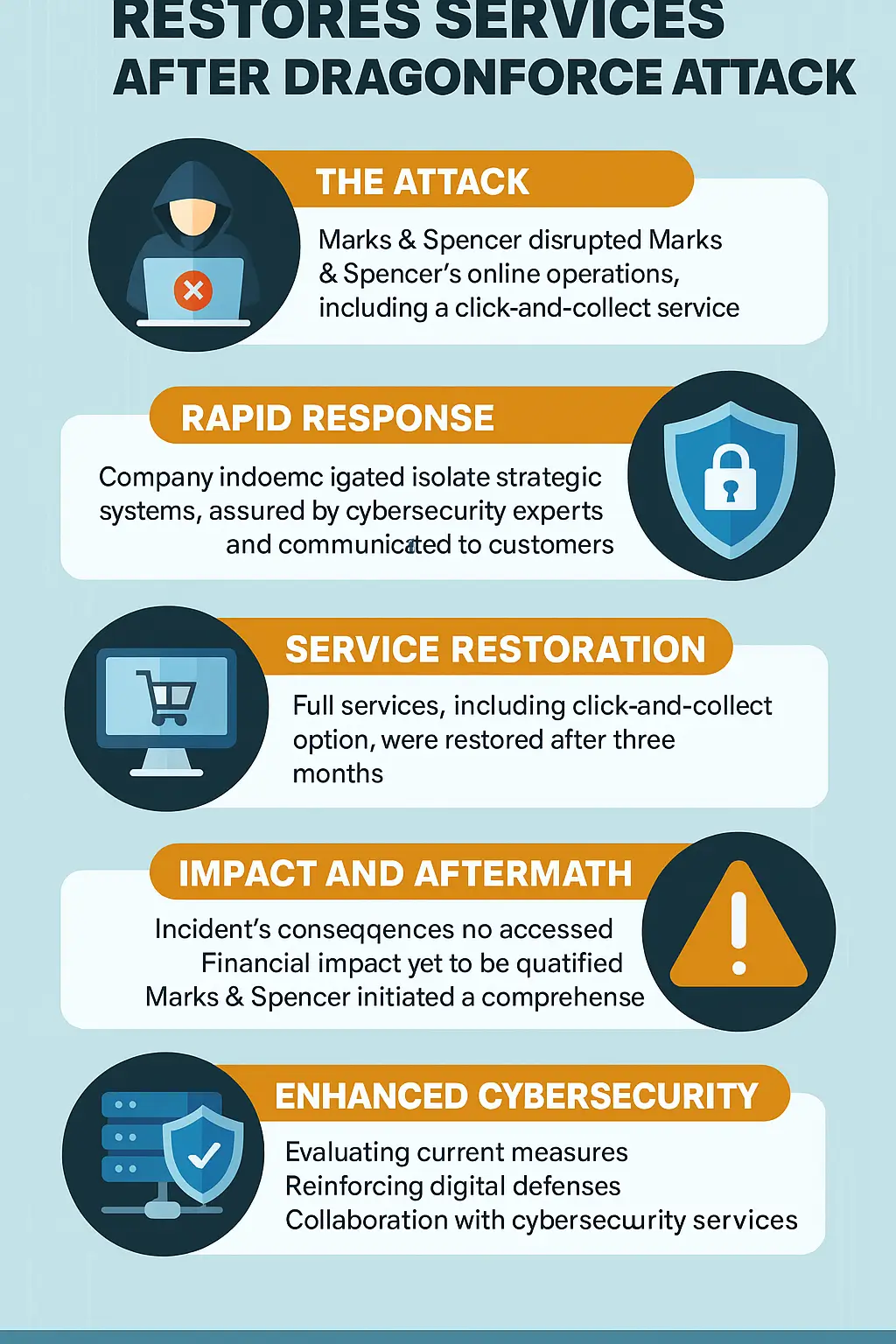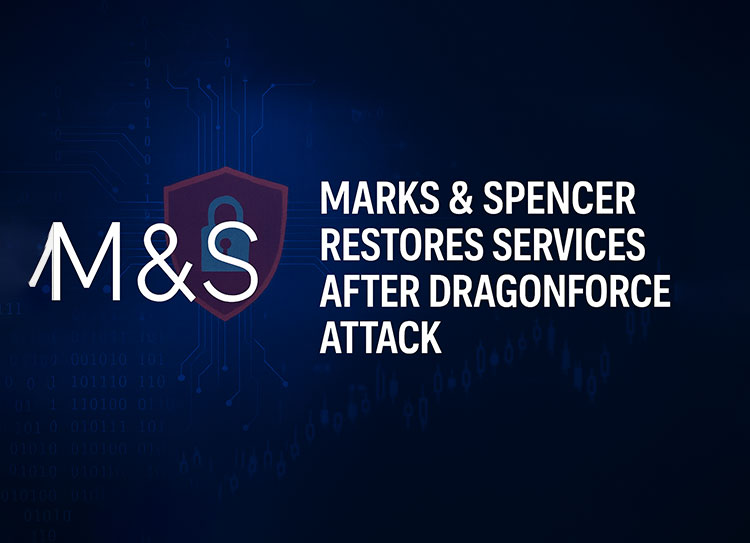Marks & Spencer Restores Services After DragonForce Attack: A Cybersecurity Wake-Up Call for Global Retail
For 15 long weeks, millions of Marks & Spencer customers found themselves locked out of one of Britain’s most trusted shopping lifelines. The culprit wasn’t a warehouse strike or supply chain disruption—it was a ruthless cyber onslaught by the hacking collective DragonForce. Now, with services finally restored, the recovery of M&S tells a story that goes far beyond one retailer’s struggle. It’s a modern parable of resilience, digital trust, and the urgent role of cybersecurity services in protecting global commerce.

The Day the Lights Went Out Online
On an otherwise ordinary spring morning, Marks & Spencer’s technical teams detected unusual activity across their servers. At first, the alerts looked like routine anomalies, but within hours, a chilling reality unfolded: DragonForce, an infamous ransomware group, had successfully breached M&S’s systems.
By midday, M&S customers attempting to use the retailer’s popular “click-and-collect” option were greeted not with order confirmations but with error messages. Online deliveries slowed to a halt, customer service centers were overwhelmed, and a legacy brand—trusted for nearly 140 years—suddenly faced a very modern nightmare.
The attack was not merely disruptive. It was surgical. DragonForce encrypted critical databases, disabled transaction gateways, and demanded ransom payments to unlock the systems. The hackers left behind a chilling message: pay up, or risk further exposure of sensitive customer data.
DragonForce: The Shadow Player Behind the Curtain
To understand the magnitude of the incident, one must first understand the attackers. DragonForce is no ordinary cybercriminal syndicate. Over the past decade, the group has cultivated a reputation for targeting high-profile institutions across Europe, Asia, and the United States. Their strategy blends ransomware extortion with psychological warfare, often releasing partial leaks of stolen data to pressure victims into compliance.
M&S became DragonForce’s latest high-value target, not only because of its iconic reputation but also because of the treasure trove of consumer payment data, loyalty information, and supplier contracts within its systems. In the evolving landscape of cybercrime, retailers are no longer just merchants—they’re vaults of digital gold.
The Customer Fallout
The impact of the attack rippled far beyond the corporate headquarters. In towns across the UK and in international hubs, loyal shoppers were suddenly unable to collect school uniforms, groceries, and essentials they had come to rely upon.
“I’ve ordered my children’s uniforms from M&S every year,” said Helen Rowe, a mother of two in Durham. “For the first time in over a decade, I had to scramble to find alternatives. It wasn’t just inconvenient—it broke a routine I trusted.”
Across social media, frustration mixed with sympathy. Some customers vented anger over delays, while others voiced concern over the safety of their personal data. The incident reminded consumers of a bitter truth: even household brands are not immune to cyberattacks.
The 15-Week Struggle for Restoration
Unlike minor outages, restoring services after a ransomware attack is a marathon, not a sprint. For 15 weeks, M&S teams—working hand-in-hand with external cybersecurity services providers—fought an invisible war.
Step One: Containment
The first priority was to isolate infected systems and prevent further spread. This meant temporarily shutting down vital customer-facing portals, a painful but necessary move.
Step Two: Investigation
Digital forensics experts worked around the clock, tracing the origin of the breach, mapping compromised systems, and identifying whether customer data had been exfiltrated.
Step Three: Recovery
Rebuilding databases from secure backups, restoring click-and-collect services, and testing transaction pipelines took weeks of painstaking effort. M&S refused to confirm whether a ransom was paid, citing security concerns, but emphasized that restoring operations safely was its top priority.
Step Four: Communication
Transparency played a central role. Weekly updates were issued to customers, regulators, and investors, balancing honesty with caution. In an age where consumer trust can vanish overnight, communication was as vital as code patches.
Services Restored—But at What Cost?
When Marks & Spencer finally announced the full restoration of services, the relief was palpable. Customers could once again place orders, collect groceries, and rely on the seamless digital shopping experience they had come to expect.
But recovery came with a cost. Financial analysts estimate the company may have lost tens of millions in direct revenue, not to mention the untold reputational damage. For a publicly traded retailer, such losses ripple into share prices, investor confidence, and long-term brand equity.
Cybersecurity Services: The Hidden Heroes
Behind the headlines of restored services lies an unsung army of cybersecurity professionals. From global consulting firms to in-house specialists, these experts worked tirelessly to rebuild trust in the M&S ecosystem.
This attack underscores a sobering truth for all retailers: cybersecurity services are no longer optional overhead—they are essential infrastructure. Protecting against ransomware, phishing scams, and supply chain vulnerabilities is now as critical as managing stock levels or staffing stores.
“Cybersecurity is the new customer service,” explained one M&S executive in a post-restoration briefing. “If people cannot trust us to protect their data, they will not shop with us, no matter how good our products are.”
A Broader Lesson for Global Retail
The DragonForce attack on M&S is not an isolated incident. From Target in the U.S. to JD Sports in the UK, retailers have become frequent targets for hackers exploiting digital transformation’s rapid pace.
Why retailers? Because they are uniquely exposed. They manage vast amounts of personal data, operate sprawling supply chains, and rely on interconnected systems that are only as strong as their weakest link.
In this sense, the Marks & Spencer story is less about one company’s crisis and more about a global industry at a crossroads. Retailers must choose between continuing to treat cybersecurity as an afterthought or elevating it to board-level strategy.
The Human Side of Cyber Resilience
Behind every breach are not just faceless corporations but people—employees who spent sleepless nights mitigating damage, customers who lost confidence, and communities temporarily cut off from services.
At M&S, staff from call centers to IT departments became frontline responders. Many worked weekends to reassure anxious customers, reset accounts, and field thousands of calls about data safety. This human resilience is as much a part of the recovery story as any software patch.
Looking Ahead: Building Cyber-Resilient Retail
The M&S recovery offers critical lessons:
- Invest in Cybersecurity Services Proactively
Waiting until after an attack is too late. Continuous investments in endpoint protection, intrusion detection, and AI-driven threat analysis are now retail necessities. - Adopt Zero-Trust Architectures
Retailers must assume breaches will happen and limit lateral movement within networks. - Prioritize Crisis Communication
Transparency builds trust, even in the middle of chaos. - Train Employees as Cyber Defenders
From cashiers to executives, everyone has a role in identifying phishing attempts and suspicious activity.
Conclusion: A Wake-Up Call Heard Worldwide
Marks & Spencer restores services after DragonForce attack—but the real restoration is of trust. For customers, it means knowing their retailer has learned, adapted, and strengthened. For the retail industry, it’s a wake-up call that cybersecurity is no longer a back-office concern but a frontline business priority.
In North Carolina, across the United States, and around the globe, retailers watching the M&S saga unfold are now asking themselves: if it happened to them, are we prepared?
The digital battlefield has shifted. In 2025, it is not enough to offer good prices and quality products. The greatest value retailers can deliver is trust—and that means making cybersecurity services the backbone of modern commerce.

